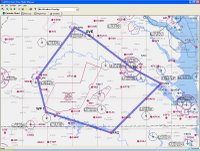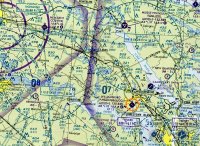Goals:
- Play with the VOR, again, with the correct frequencies.
- Short-field landings.
Flight:
After completing the pre-crank-up checklists, I sat in 388 for a few minutes and wrote up my maneuver card for today. 1. Clearing turns (with a box around it for emphasis). 2. VOR #1 -- HPW -- 112.0. 3. VOR #2 -- HCM -- 108.8. 4. ADF -- FAF -- 226. 5. Short-field landings. I checked the sectional again and again. I visualized it mentally against the rivers, peninsula and setting sun. I thought about general bearings from JGG to HPW to HCM to JGG. I checked the sectional again for other airports (FYJ quite close to HCM, RIC a little ways past HPW) that I'd be near so I could tune them in, if appropriate. With HPW in the active nav2 position and HCM in standby, the rest of the preflight commenced.
After a short-field takeoff, I headed up-river and dialed the OBS to take me to the HPW VOR. I think it was ~295 (note to self -- maybe write these things down while learning!), and I turned onto that heading. The wind was 3 kts from 160 (which some smokestacks on the south side of the river corroborated), and I did find that I was drifting right of track ever so slightly.
It was a relatively long leg of the flight, more so than anything else I've done alone. HCM is ~22 nm from JGG, and I'm endorsed for up to 25 nm from home base. I got up to ~2700' and did the cruise checklist, which included trim, throttle back to 75% and lean. I got in plenty of scan-for-traffic practice, and even a little sight-seeing. It was also a good opportunity to practice reading the sectional and picking out landmarks relative to where I wanted to go.
 (That's an image just above this text -- it shows up fine on Windows but it's not showing up for me in FireFox on OSX, but click it for a bigger view. Same goes for the pic below the paragraph about the landings.)
(That's an image just above this text -- it shows up fine on Windows but it's not showing up for me in FireFox on OSX, but click it for a bigger view. Same goes for the pic below the paragraph about the landings.)As I drew close, I decided to do a turn around a point, the point being the bright white VOR sombrero -- if I had a soundtrack, you can guess what it would have been playing. I put the mixture back in, slowed to ~120 and descended to 2500' to do the turn. It seemed mediocre, but I did enter on downwind and tried to manage my bank appropriately. (I know, "popular" landmarks shouldn't be used for practicing maneuvers to minimize the likelihood of encountering traffic. I didn't think of that at the time. Husband chided me a little, adding his story that during his instrument training they were doing a VOR approach and had to abort because someone was practicing stalls over the VOR. I won't make that mistake again.)
That done, I throttled back up and climbed to 3000' heading NE. With the nav2 swapped for HCM to be active, I dialed it up to verify the direction from me to it. I may be crazy, but I swear I could see the HCM VORTAC glowing across the York. (Note to self -- how far is that? 10-12 nm?) Once established, I decided to first overfly FYJ then pick up the 170 radial to get me pointed right back to JGG. I dialed in 170 and the needle went far left, as expected. There were two other aircraft working FYJ, so at 8 nm out I announced that I'd be flying straight north at 3000' (again with the bad assessment of direction -- I'd be flying NE); over the next few minutes the three of us stayed coordinated and in sight, so that was a neat exercise. Once past the field, the needle came alive and I turned (late) to the SE to get on it. When I was established on 170, due to the late turn, the radial was to my right, as the needle indicated, so I chased it and got on track.
I crossed the VOR and headed back toward JGG. Still actively scanning for traffic and squinting against the setting sun, I switched the comm back to JGG and had a moment of indecision. I was 10 miles out and pointed straight at the airport on the approach end of the favored runway. How did I want to enter the pattern? The typical scenario for my training flights has me coming back to the airport from the west, so it's a no-brainer to intercept either the 45 for left downwind for 31 or the 45 for right downwind for 13. But here I was coming from the north for right 13 traffic. I could swing off to the west and come in over Jamestown Island like usual, I could overfly at midfield and get in on downwind, or I could go wide and enter on crosswind.
I didn't want to go out of the way to the west, mostly just because I wouldn't learn to do something new by doing the same old thing. I didn't want to cross midfield because I wanted all the time I could get on downwind to make sure I got set up properly for a short-field landing. So I opted for the crosswind entry. As I got close to the airport, I could see a plane doing his run-up off the end of 13, so I announced my intentions and he responded that he saw me and would wait for me to get established in the pattern before taking the runway (turns out he needed more time for the run-up and he waited for me to land).
Anyway, long story short (AGAIN! Shall I practice succinctness in these posts as well as on the radio?!?), I had a comfortable amount of time to get my airspeed down and get everything done for a short-field landing that was oh-so-very-close to what I wanted, but I missed the windsock turn-off by probably 15' and so scooted to the midfield turn-off.
I went around three more times, one of which was a practice go-around from a full-flaps approach. The two landings were good, and I did make the windsock turn-off for both. The last one was the best, and it was the slowest of the three -- ~65 mph at a glide. POH says 69 mph with 40 degrees of flaps, so I was a little slower than recommended, but it worked to get me down from ~450' above the field with a short landing. I realized what part of my problem yesterday was, too. On 13, you have to cut the corner from base to final to avoid flying over the school, so shooting for a start-of-final altitude of 500' over field elevation doesn't make as much sense as when the final leg is full length. In the snapshot below, you can see that the two nice and short landings corresponded to slightly longer finals; it was probably not a big enough difference to matter, but between that and lower power and a slightly lower starting-final altitude, it worked.

You know, GPS is pretty cool. I just looked closer in the Garmin MapSource software's collection of points for today's track. When I touched down on my last landing, I was going 40 mph (average speed for that sample point), which also happens to be the stall speed with flaps. The previous data point was taken at 142' MSL (~100' above the field) and the average speed there was 61 mph. From touchdown to turnoff was right at 600'.
Discussion:
- VOR practice: Much improved today. I made up for being a stupid user yesterday. Next time I need to work with the reverse sensing aspects of the indicator.
- Short-field landings: Slow, slow, slow is the key! The biggest thing for me to be that slow on final was to pull out the power on base, while still ensuring that I'd be ~500' AGL when turning final. Also big was to not overdo the downward pitch (with so much flaps hanging out there it seemed easy to overcompensate) which would cause the airspeed to build up.
- Aborted short-field landing: The good thing about choosing to abort on a short-field landing is that you're higher than you would normally be on (short) final. The bad thing about choosing to abort on a short-field landing is that you've got 40 degrees of flaps out there (in 388).
I knew what I was going to do and I did it. I simultaneously announced the go-around as I leveled off and pushed in the carb heat and throttle. I immediately then put the flaps up to 20 degrees, and had to wrangle the pitch attitude a little to keep level while accelerating. Once I hit Vy, I let 388 climb and eased in the rest of the flaps a little at a time. It wasn't a happy comfortable maneuver, but it was good to do, and good to see that nothing scary or unexpected happened. Had I really expected surprises, I wouldn't have done it alone!
Self-Assessment: Coming along... I've decided to condense this assessment section since many of the procedures/maneuvers are under control now; I'll leave bold and separate the items that I feel still need applied effort to improve, with the footnote that they
all still need constant
practice at this point!
Flying- Preflight, taxiing, normal takeoff, short-field takeoff: Good.
- Soft-field takeoff: Needs practice.
- Maintaining airspeed, stalls, slow flight (VR/IR), maintain/change attitude/altitude/heading by instruments: Good.
- Recover attitude, altitude, heading by instruments: Acceptable.
- Forced landing: Good, need more practice.
- Forward slip:: Dunno, needs more practice.
- Pattern, radio calls, normal landing, directional control after landing: Good.
- Crosswind landing: Improved.
- Short-field landing: Improved.
- Soft-field landing: Not sure...
Navigating- ADF: Okay for an intro, needs practice.
- VOR: Improved, needs practice.
Next: I've got the plane at 3 pm on Tuesday for a lesson that ought to include getting signed off to land at FYJ. The syllabus calls for basically a review of everything we did in 14 -- VR/IR use of navaids and stalls, short/soft-field takeoffs and landings -- plus forward slips to a landing and more IR recovery from unusual attitudes.
- Soft-field takeoffs and landings, more short-field landings.
- Practicing everything.
Hours logged this flight: 1.3
Hours logged total: 24.6
Instrument hours logged this lesson: 0
Instrument Hours logged total: 1.3
Take-offs and landings this flight: 3
Take-offs and landings total: 69
PIC hours total::
5.7









